For this essay we decided to examine the use of English in the Finnish version of Cosmopolitan magazine. Cosmopolitan is a widely known and popular woman’s magazine published in over 30 countries, with its headquarters in the United States. Even in our small-scale research we found that English is used not only regularly, but quite excessively in the Finnish issues – although Finnish still remains the main language. In this analysis our aim is to examine the reasons behind using English instead of Finnish in this particular context.
We were motivated to map the amount of English used in a popular women’s magazine such as Cosmopolitan to see how much English is offered to its readers alongside Finnish. As stated above, the magazine uses, for example, English expressions and phrases quite excessively. Leppänen & Nikula note that English can sometimes be used to ”create a sense of shared interests and expertise”. With Cosmopolitan being as popular as it is, the use of English can perhaps create unity between ”cosmowomen” all around the world. Other possible reasons behind choosing English might be stylistic or expressional ones. Our objective here was not to compare the magazines to each other, but to rather find different occasions where English is used and then to weigh the possible reasons behind choosing to use English instead of Finnish. The magazine is aimed at young women, aged 18 and up, and thus English might also be used for attracting certain types of readers. In agreement with us, Eastman & Stein (1993) noted that English can be used as an out-group language to ”attract potential customers by appealing to their sense of what is modern, sophisticated, elegant, etc”. The target audience is an obvious influencer when it comes to the language used in the magazine, as are its recurring topics and other ”restrictions” that might be stated by this particular genre. These will be further discussed later on.
For this analysis we scanned through five magazines, four from 2015 and one from 2014. By examining these five issues, we were able to identify three types of cases where English is used instead of Finnish: headlines, recurring section headlines, and expressions. Recurring sections are ones that are in the magazine every month, which can be thus separated from, for example, a given headline on the cover, which changes every month. The reasons behind deciding to give a recurring section an English heading are perhaps the most interesting ones to be analyzed here.
The obvious defect in this study of ours is unfortunately the fact that we did not compare these issues to ones published, for example, ten years ago. However, the supposition here is that the amount of English used in the magazine has grown significantly over the years. One can safely assume that ten years ago there was a greater divide between the original Cosmopolitan and its Finnish version, whereas nowadays the gap has grown smaller and smaller.
Data


The first issue we scanned was October/2015, which has its main headline on the cover already in English: You can do it. The same occurred in December/2014, with its bright pink headline in English: Girlboss. Each issue has its own theme, which in these cases were fitness and feminism. In addition to its motivating main headline, October/2015 had three other headings in English:
Don’t mess with Demi (heading to an interview with Demi Lovato)
We can do it &
Burn baby burn (headings to fitness articles).
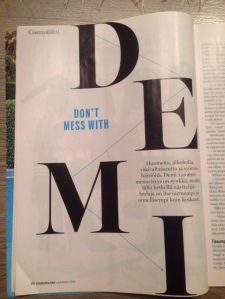

A recurring headline also occurred, as it did in all the other issues: Girl crush. Here the magazine presents a given female celebrity, her wardrobe and other reasons to look up to her. Girl crush is a term which, according to the Urban Dictionary, means ”feelings of admiration and adoration which a girl has for another girl, without sexual attraction”. Girl crush can thus be categorized a term which has no sufficient equivalent in Finnish, as for example ”tyttöihastus” does not carry the same meaning. Similar situation can be seen in October/2015, where an article for easy hairdos for short hair is called Short cut. Here the heading can be understood in two ways, while its Finnish version ”oikotie” has only one meaning. Yet again similar wordplay can be found in February/2015, where an interview with the famous 50 Shades of Grey star Jamie Dornan is called 50 Shades of Jamie Dornan.
In addition to Girl Crush, other recurring section headlines include:
Sex Master Class (advice on how to improve one’s sexlife)
Fun Fearless Female (an interview with a strong female figure one can admire)
Beauty Awards (comparing beauty products)
Body Love (wellness & fitness advice)
Walk with me (someone describes their typical work day).

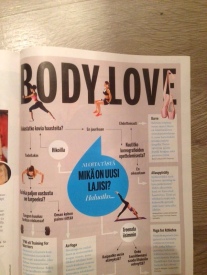
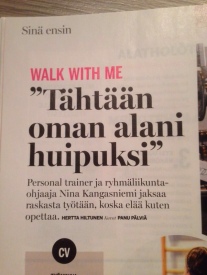
Six recurring headlines in English is quite a lot, since, according to a quick scan, only about four recurring sections have a Finnish heading : the editor-in-chief -section (Päätoimittajalta), horoscopes (Horoskooppi), a monthly test of some kind (Cosmotesti) and a section where the readers can send in their most embarrassing stories(Tunnustuksia).
And, in addition to the recurring headlines, English headings were popular in all of the five issues:
Streetstyle (fashion spread)
All around the world (travelling)
If not me, who? If not now, when? (a quote as a heading for an interview)
Little blue book (article about jeans)
Next year we’re gonna love… (a spread on things we are eager to see next year)
Work it girl! (a fitness article).
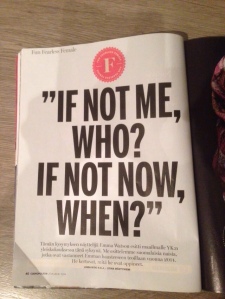

In the feminism issue (December 2014) the theme is to encourage women to be independent, confident and strong. One spread is dedicated to inspirational quotes, and what makes this interesting to us, is that 5/13 of these are in Finnish, while 8/13 are in English. Some, such as just do it, might be easy to understand, but others might require higher competence in English. One example of this is the quote ”a smooth sea never made a skillful sailor”.
In addition to all these, a seemingly large amount of other expressions occurred:
Plan B, must have, party on, #trending, hot, camel coat, #nofilter, do/don’t, never forget, they’ve got the power!, it-vauva, no makeup, back to black, fresh & healthy, finger food, #throwback, sealife…
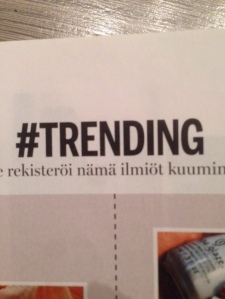
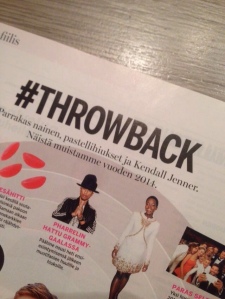
Although used excessively, these small expressions are not consistent. For example, while in some issues they use ”must have”, in others it’s in Finnish, ”pakko saada”. Similarly, ”party on” can be replaced by ”bileet pystyyn”, and so on. The hashtags, however, seem to be mostly in English. In some cases Finnish and English were mixed, as with the term ”it-vauva”.
Analysis and reflection
As a starting point, the use of English in Cosmopolitan can be easily connected to the fact that the magazine originates from the United States. Although that alone does not determine the use of English, the language can be seen as a link to globalized popular culture, which is represented in Cosmopolitans all over the world. To continue on that point, the use of English can be seen as a way to symbolize a united identity, in this case, being a ”cosmowoman”. While the issues are not similar in each country, the concept, topics and the brand are the same in all of the different versions of the magazine. The magazine encourages its female readers to be fierce and confident ”cosmowomen” and gives advice in each issue on how to be a woman of that kind. Thus, the use of English can bring the ”cosmowomen” in Finland closer to other ”cosmowomen” all around the world. The Finnish issues mentioned the term ”cosmonaiset” quite frequently. Leppänen & Nikula also agree on this and note that English can sometimes be used in situations where one aims to emphasize shared choices of ”lifestyle, identity and communality”.
As can be gathered from the cases of Girl Crush and Short cut, English is sometimes used instead of Finnish for the plain reason of its expressive value. While ”short cut” stands for an easy way out, it also refers to a short hairdo and is thus a well-suited heading for an article which gives advice on how to style one’s short hair easily. Although, with the case of Girl Crush, one can only wonder if all the readers know the meaning of the term, or whether the idea of that section remains unclear to some of them.
With You can do it, the reasons behind having the main headline on the cover of the magazine in English might be expressional, too. One can assume that the majority of Finnish people know the meaning of you can do it, even if they are not competent in English otherwise. With Girlsboss, the reasons might vary. They might be stylistic, as ”tyttöpomo” might not sound as confident and fierce as girlboss. The theme of the magazine was feminism, after all.
Another theme that seemed to attract English was fitness. Headings such as We can do it!, Burn baby burn and Work it girl! seem to occur quite regularly. These could, however, be easily translated into Finnish. Although one can still assume that, again, the majority knows what ”work it girl” means. Alongside fitness, notably, fashion was a theme that included a lot of English. Here, English was used with terms such as streetstyle, trending and camel coat. Again, ”kamelitakki” might not be stylistic enough, while on the other hand ”katumuoti” might work. But, as mentioned earlier, these terms and expressions were not consistent. Some of them were in English, some of them in Finnish, and the same term might even occur in both languages in different parts of the magazine. All of these types of cases we might call mixing & matching the two languages.
Although Cosmpolitan uses English quite excessively, there were occasions where Finnish was chosen instead of English, even if the quality of the translation turned out to be not quite competent enough. December/2014 did an article on the new lingerie collection by Britney Spears, which is originally called Intimately, Britney Spears. The Finnish Cosmopolitan, however, decided to use Finnish and give their article a Finnish heading: Henkilökohtaisesti, Britney Spears. Here, the reason behind wanting to translate the title might be that of being concerned whether everyone understands the word ”intimately”. There might be an interesting research to be done in this area: finding out how competent the editors of the Finnish Cosmopolitan (and/or other magazines) expect an average Finn to be in English. They might believe an average reader knows the meaning behind work it girl, but what about expressions such as it-vauva? If a given reader is not farely competent in English, they might not know what it means in any given context. The same can happen with the feminism issue and its English quotes.
In conclusion, English seems to be gaining ground and appearing regularly alongside Finnish in the Finnish version of Cosmopolitan magazine. English can be seen in small bits and pieces here and there, but also in main headings and recurring section headlines. Most of the time the reasons behind using English can be stylistic or expressional, but sometimes one can only wonder why English has been chosen instead of Finnish. In some ways it can be seen as an additional resource used alongside Finnish, when, for example, one can not find a suitable Finnish expression to be used as a headline for a given topic. Only time will tell whether English will gain even more ground in Cosmopolitan and other similar media settings, and in what ways.
Sources:
Eastman, Carol M. & Roberta F. Stein. 1993. “Language display: Authenticating claims to social identity.” Journal of multilingual and multicultural development.
Leppänen, Sirpa & Tarja Nikula. 2007. “Diverse uses of English in Finnish society: discourse‐pragmatic insights into media, educational and business contexts”. Multilingua 26(4).

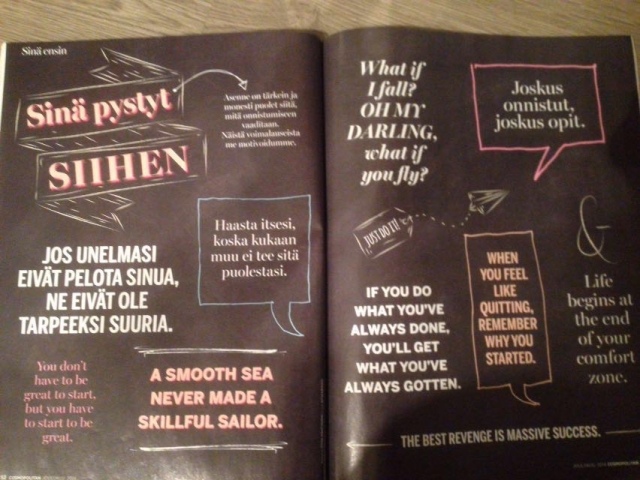
Pingback: Girlboss, you can do it! – English as an additional resource in Cosmopolitan | English in Finland 2016